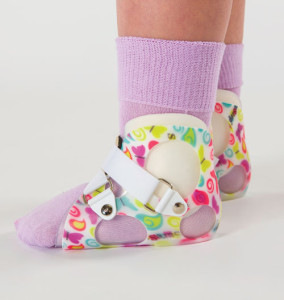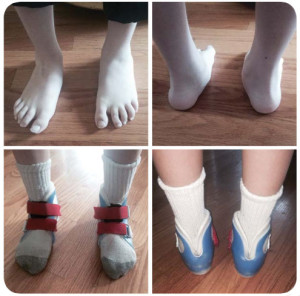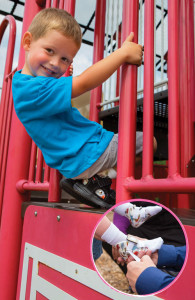 AFO Mechanics
AFO Mechanics
SureStep manufactures a variety of products but is primarily known for the SMO (Supra malleolar orthosis) and pediatric AFOs (ankle foot orthosis). The SureStep SMO is meant for patients up to 80 pounds with hypotonic presentations. The purpose is to control the side to side movements of the ankle. The trim lines can be extended longer laterally or medially depending on whether the patient is pronating or supinating. As patients grow older there is a device called the Big Shot that accommodate children and adults weighing over 80 pounds. What makes the SureStep SMO so unique is the dynamic function that the brace allows. It uses compression to create alignment, unique trim-lines to allow freedom of motion where needed, and made from a material that travels together along with the foot.
Controling the Tri-Planar Deformities
This works under compression to maintain stability through midline. In young patients with CMT they can possibly present with a more over pronated foot position because of the low muscle tone (hypotonia) prior to developing a high arch foot presentation. This can been seen in CMT patients who have some symptoms of the disease but have not developed a high arch otherwise known as pes cavus foot. The SMO holds the heel in vertical alignment, giving stability in a coronal plane (side to side) position. An SMO is not necessarily for a patient who has weaknesses pushing up or down the ankle, just poor side-to-side movement.
Improving Stability During Gait
The device is designed to allow for motion to still occur from in and out of the midline position but limits the extremes that the foot would go to, in other words the extreme rolling inward our outward of the ankle. The goal is to improve balance and stability, or limit orthopedic injury. This helps limit out toeing or in toeing as well by improving the position to foot is landing on the ground. Having improved alignment may also utilize remaining strength for dorsiflexion or plantarflexion because the line of pull that these muscles are in has improved line of progression.
Fitting the Device
The trim-lines of the SureStep SMO are designed to be either longer on the lateral border for pronation or medial border for patient who supinate excessively and the orthotist should make the appropriate selection based on the patient’s mechanics. These trim-lines are critical to the successful outcome of this device. Although the SureStep SMO is primarily designed for a younger population as children get older or adults who still have need for such a device the same mechanism of function can be accomplished using the BigShot SMO manufactured by SureStep.
Device Warranty
SureStep products are guaranteed for fit, materials, workmanship and growth for ninety (90). During that time, should there be a problem, we will adjust, repair or replace the brace at no charge.
Case Study:
Sean McKale – CO
Midwest Orthotics & Technology Center
Introduction
Children with developmental delays with familial history of Charcot Marie Tooth (CMT) disease should be looked at with careful considerations. Developing early gross movement patterns are important in maintaining functional movement throughout life. CMT can have associated lower muscle tone, and despite muscles still having strength to move the foot and ankle muscle tone may affect the resting posture that the person is aligning. Maintaining improved biomechanical alignment can help facilitate motion in the muscles as they continue to function, prevent orthopedic injury, limit fatigue, and increase stability. Depending on the level of impairment will determine the necessary level of orthotic prescribed.
Patient profile – Surestep Bigshot SMOS
Patient is a 5-year-old male with the diagnosis of Charcot Marie Tooth 1a, whose 35-year-old father is also diagnosed with CMT and is now wearing AFOs. He is being evaluated for orthotics because he has trouble keeping up with other children his age. He has no orthotic history, but because of his father’s experience the family felt orthotics could be beneficial. He was delayed in walking as he did not take his first steps until almost 2 years of age. Currently, he has difficulty jumping and running, which are his primary complaints. Due to low muscle tone, his ankle collapses into an overpronated foot position. He stands with a wider base of support, and his feet appear to be externally rotated below him. He has the ability to lift up his ankle into dorsiflexion, and step up onto his toes. However, he has poor endurance to do so. When he attempts to jump, his feet do not fully elevate off of the ground.
Patient’s ankle position is correctable to neutral alignment with good flexibility. Primary orthotic goals will be to maintain neutral coronal foot alignment. An SMO was discussed with the family versus a foot orthotic, because of the advantage of lever arm that the orthotic has.
SMO Design
Patient was fabricated bilateral SureStep Bigshot Lite SMOs. This brace offers correction through compression. It also allows for freedom of the forefoot to come into contact with the ground, which can help proprioception and intrinsic muscle positioning. By correcting the coronal foot position (side-to-side) this will allow the patient to better utilize the muscles that are responsible for lifting up and pushing downward at the ankle. An example of this is, it is much easier to pull a garden hose straight on versus pulling it around the corner of your house. The Bigshot Lite was selected because of the patient’s weight and activity level.
Results and Discussion
When the patient was first fit with SMOs, he remarked that they were comfortable to use, had improved heel-toe progression, and had improved ability to push up onto his toes in standing.
Patient was seen again at 6 month follow-up for strap replacement. Braces were still fitting appropriately, and would anticipate child at this age to wear SMOs for one year or slightly longer. Patient had improved ability to jump and run. Parents remarked that they noticed improved differences in his playing abilities and keeping up with peers. Plan was to continue wearing SMOs until he outgrew them to maintain quality of movement and develop further patterning of gait. Anticipation to progress through a foot orthotic as he outgrows them to maintain joint stability and improved biomechanics.
This patient may require use of AFOs as his CMT progresses. But having improved alignment will make him more manageable in the future and especially in early childhood developing movement patterns is particularly important. It is known that we develop our adult gait pattern by the age of 7, so early intervention can be very important in developing improved biomechanics.













